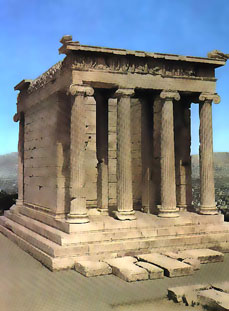
Ancient Athens Temple of Athena Nike
This jewel of Attic architecture, better known (though incorrectly so), as the Temple of Apteros Nike, or Wingless Victory, is the work of the celebrated Callicrates. Standing on a 9.50 m. high bastion, it was erected by order of Pericles in the fifth century BC and dedicated by him to the goddess Athena in commemoration of the great Athenian victories over the Persians.
In prehistoric times this rocky pedestal, on which the with Boeotians, allies of the Persians, at the Battle of Plataea.
The entrance to the sanctuary, through the east portico, was formed by two pillars connected with the antae by a balustrade. Here stood the cult statue, a very ancient wooden image (xoanon) representing the goddess Athena holding a pomegranate, symbol of fertility, in her right hand and her helmet in the left.
The Temple of Athena Nike embodies the ethereal beauty and noble austerity that is characteristic of Attic art. It was still standing as late as 1676 but was demolished in 1687 by the Turks, who used the material to strengthen their defenses against the Venetians with whom they were at war. Its reconstruction was carried out between 1834 and 1838 by Ross, Schaubert, and Hansen, largely from fragments built into the Turkish fortifications. Later, in 1936, and recently more accurate reconstructions were carried out.
In antiquity the three sides of the bastion were surmounted by a marble balustrade with a bronze rail, and the outer surfaces of the large marble slabs forming this balustrade were ornamented with bas-reliefs depicting Winged Victories setting up trophies and leading sacrificial animals into the presence of the goddess. The grooves into which the slabs were bedded are still visible on the west and north edges of the platform.
